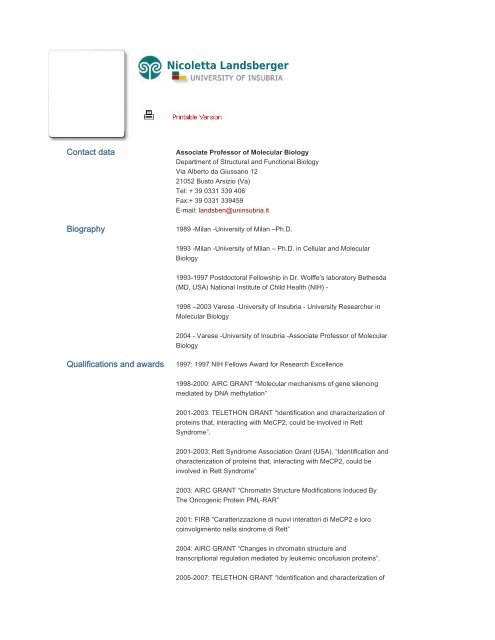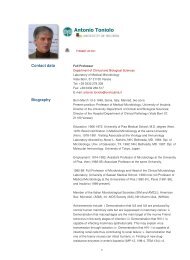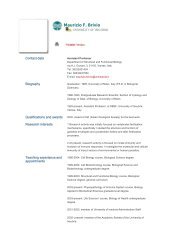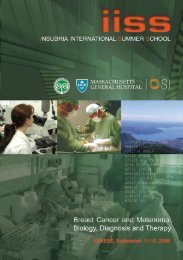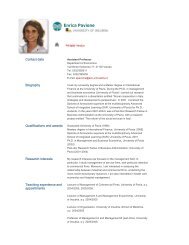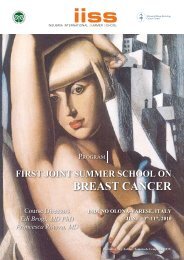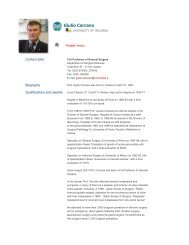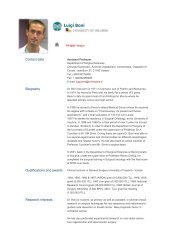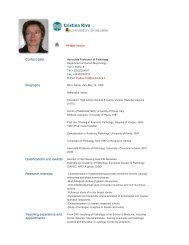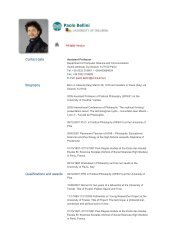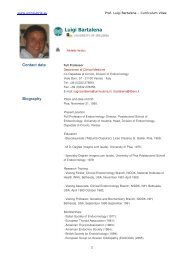Nicoletta Landsberger - The University of Insubria
Nicoletta Landsberger - The University of Insubria
Nicoletta Landsberger - The University of Insubria
You also want an ePaper? Increase the reach of your titles
YUMPU automatically turns print PDFs into web optimized ePapers that Google loves.
<strong>Nicoletta</strong> <strong>Landsberger</strong><br />
Contact data Associate Pr<strong>of</strong>essor <strong>of</strong> Molecular Biology<br />
Department <strong>of</strong> Structural and Functional Biology<br />
Via Alberto da Giussano 12<br />
21052 Busto Arsizio (Va)<br />
Tel: + 39 0331 339 406<br />
Fax:+ 39 0331 339459<br />
E-mail: landsben@uninsubria.it<br />
Biography 1989 -Milan -<strong>University</strong> <strong>of</strong> Milan –Ph.D.<br />
1993 -Milan -<strong>University</strong> <strong>of</strong> Milan – Ph.D. in Cellular and Molecular<br />
Biology<br />
1993-1997 Postdoctoral Fellowship in Dr. Wolffe’s laboratory Bethesda<br />
(MD, USA) National Institute <strong>of</strong> Child Health (NIH) -<br />
1998 –2003 Varese -<strong>University</strong> <strong>of</strong> <strong>Insubria</strong> - <strong>University</strong> Researcher in<br />
Molecular Biology<br />
2004 - Varese -<strong>University</strong> <strong>of</strong> <strong>Insubria</strong> -Associate Pr<strong>of</strong>essor <strong>of</strong> Molecular<br />
Biology<br />
Qualifications and awards 1997: 1997 NIH Fellows Award for Research Excellence<br />
1998-2000: AIRC GRANT “Molecular mechanisms <strong>of</strong> gene silencing<br />
mediated by DNA methylation”<br />
2001-2003: TELETHON GRANT “Identification and characterization <strong>of</strong><br />
proteins that, interacting with MeCP2, could be involved in Rett<br />
Syndrome”.<br />
2001-2003: Rett Syndrome Association Grant (USA). “Identification and<br />
characterization <strong>of</strong> proteins that, interacting with MeCP2, could be<br />
involved in Rett Syndrome”<br />
2003: AIRC GRANT “Chromatin Structure Modifications Induced By<br />
<strong>The</strong> Oncogenic Protein PML-RAR”<br />
2001: FIRB “Caratterizzazione di nuovi interattori di MeCP2 e loro<br />
coinvolgimento nella sindrome di Rett”<br />
2004: AIRC GRANT “Changes in chromatin structure and<br />
transcriptional regulation mediated by leukemic onc<strong>of</strong>usion proteins”.<br />
2005-2007: TELETHON GRANT “Identification and characterization <strong>of</strong>
proteins that, interacting with MeCP2, could be involved in Rett<br />
Syndrome”.<br />
2005-2007: AIRC GRANT“Changes in chromatin structure and<br />
transcriptional regulation mediated by leukemic onc<strong>of</strong>usion proteins”.<br />
Research interests In general my interest has always been in the field <strong>of</strong> chromatin and<br />
transcription. This became clear when I joined Dr. Wolffe's laboratory<br />
as a postdoctoral fellow. I have been in the Alan laboratory for 4.5<br />
years. In 1998 I left NIH and I started my own group in Italy. Generally,<br />
the group is interested in analyzing the mechanisms <strong>of</strong> gene silencing<br />
driven by DNA methylation with a particular interest in the identification<br />
<strong>of</strong> novel proteins that by interacting with the methyl-binding protein<br />
MeCP2 might be involved in Rett Syndrome; moreover the laboratory is<br />
working on the influence <strong>of</strong> the main regulators <strong>of</strong> acute promyelocytic<br />
leukemia on gene expression and chromatin structure.<br />
Teaching experience and<br />
appointments<br />
Representative<br />
publications<br />
Regarding the MeCP2 interacting factors we have recently used a<br />
deductive approach and a genetic one to isolate novel interacting<br />
factors. We believe this strategy quite important to isolate novel loci<br />
either involved in Rett syndrome onset or in influencing its gravity.<br />
Some <strong>of</strong> these interactors have been further characterized in the<br />
laboratory.<br />
1998/2001 - Laboratory <strong>of</strong> Experimental Biology II. <strong>University</strong>. <strong>of</strong><br />
<strong>Insubria</strong>; degree in Biology.<br />
2000/2006 Methodologies in Molecular Biology. 5 CFU. <strong>University</strong> . <strong>of</strong><br />
<strong>Insubria</strong>. 1st level degree in Biology.<br />
2000/2003 – Gene expression regulation during development.<br />
<strong>University</strong>. <strong>of</strong> <strong>Insubria</strong>; degree in Biology.<br />
2002/2004 – Subjects <strong>of</strong> Molecular Biology. 3 CFU. <strong>University</strong>. <strong>of</strong><br />
<strong>Insubria</strong>; Second level degree in Biology.<br />
2003/2006 Molecular Biology II. 4 CFU. Univ. <strong>of</strong> <strong>Insubria</strong>. Graduate<br />
level degree in Biology Applied to Biomedical Sciences.<br />
2004/2006 Integrated Laboratory I: unit <strong>of</strong> Molecular Biology. 1 CFU.<br />
<strong>University</strong> <strong>of</strong> <strong>Insubria</strong>. Undergraduate level degree in Biology <strong>of</strong> Health.<br />
2004//2006 1.5 CFU <strong>of</strong> Epigenetic Univ. <strong>of</strong> Vita e Salute (Milan).<br />
Graduate level degree in Medical, Molecular and Cellular<br />
Biotechnologies.<br />
2005: Epigenetic mechanisms <strong>of</strong> transcriptional regulation. 3 CFU.<br />
<strong>University</strong> <strong>of</strong> <strong>Insubria</strong>; Graduate degree in Biology.<br />
1) DG. Stump, N. <strong>Landsberger</strong> and A. P. Wolffe (1995) <strong>The</strong> cDNA<br />
encoding Xenopus laevis heat-shock factor 1 (XHSF1): nucleotide and<br />
deduced amino-acid sequences, and properties <strong>of</strong> the encoded protein.<br />
Gene 160, 207-211.
2) N. <strong>Landsberger</strong>, M. Ranjan, G. Almouzni, D. Stump and A. P. Wolffe<br />
(1995) <strong>The</strong> heat shock response in Xenopus oocytes, embryos and<br />
somatic cells: a regulatory role for chromatin. Dev Biol. 170, 62-74.<br />
3) N. <strong>Landsberger</strong> and A. P. Wolffe (1995) Role <strong>of</strong> chromatin and<br />
Xenopus laevis heat shock transcription factor in regulation <strong>of</strong><br />
transcription from the X. laevis hsp70 promoter in vivo. Mol. Cell. Biol.<br />
15, 6013-6024.<br />
4) G. Badaracco, M. Bellorini and N. <strong>Landsberger</strong> (1995) Phylogenetic<br />
study <strong>of</strong> bisexual Artemia using random amplified polymorphic DNA. J<br />
Mol Evol 41, 150-154.<br />
5) S. U. Kass, N. <strong>Landsberger</strong> and A. P. Wolffe (1997) DNA<br />
methylation directs a time-dependent repression <strong>of</strong> transcription<br />
initiation. Current Biology 7, 157-165.<br />
6) N. <strong>Landsberger</strong> and A. P. Wolffe (1997) Remodeling <strong>of</strong> regulatory<br />
nucleoprotein complexes on the Xenopus hsp70 promoter during<br />
meiotic maturation <strong>of</strong> the Xenopus oocyte. EMBO J. 16, 4361-4373.<br />
7) Peter L. Jones, Gert Jan C. Veenstra, Paul A. Wade, Danielle<br />
Vermaak, Stefan U. Kass, <strong>Nicoletta</strong> <strong>Landsberger</strong>, John Strouboulis &<br />
Alan P. Wolffe (1998) Methylated DNA and MeCP2 recruit histone<br />
deacetylase to repress transcription. Nature Genetics 19, 187-191.<br />
8) Motta MC., <strong>Landsberger</strong> N., Merli C., and Badaracco G. (1998) In<br />
vitro reconstitution <strong>of</strong> Artemia satellite chromatin. J. Biol. Chem. 273,<br />
18028-18039.<br />
9) Li Q., Herrler M., <strong>Landsberger</strong> N., Kaludov N., Ogryzko V.V.,<br />
Nakatani Y., and Alan P. Wolffe. (1998) Xenopus NF-Y pre-sets<br />
chromatin to potentiate p300 and acetylation-responsive transcription<br />
from the Xenopus hsp70 promoter in vivo. EMBO J. 17, 6300-6315.<br />
10) Chandler, S. P., Guschin, D., <strong>Landsberger</strong>, N. and Wolffe, A.P.<br />
(1999) <strong>The</strong> methyl-CpG binding transcriptional repressor MeCP2 stably<br />
associates with nucleosomal DNA. Biochemistry 38, 7008-7018.<br />
11) Doren, S., <strong>Landsberger</strong>, N., Dwyer, N., Gold, L., Blanchette-<br />
Mackie, J. and Dean, J. (1999) Incorporation <strong>of</strong> mouse zona pellucida<br />
proteins into the envelope <strong>of</strong> Xenopus laevis oocytes. Dev Genes Evol.<br />
209, 330-339.<br />
12) Minucci S., Maccarana M., Cioce M., De Luca P., Gelmetti V.,<br />
Segalla S., Di Croce L., Giavara S., Matteucci C., Gobbi A., Bianchini<br />
A., Colombo E., Schiavoni I., Badaracco G., Hu X., Lazar M.A.,<br />
<strong>Landsberger</strong> N., Nervi C., Pelicci P.G. (2000) Oligomerization <strong>of</strong> RAR<br />
and AML1 transcription factors as a novel mechanism <strong>of</strong> oncogenic<br />
activation. Mol. Cell 5, 811-820.<br />
13) Curradi, M., Izzo, A., Badaracco, G. and <strong>Landsberger</strong> N. (2002)<br />
Molecular mechanisms <strong>of</strong> gene silencing mediated by DNA<br />
methylation. Mol. Cell Biol. 22, 3157- 3173.
14) Segalla S., Rinaldi L., Kilstrup-Nielsen C., Badaracco G., Minucci<br />
S., Pelicci PG., and N. <strong>Landsberger</strong> (2003) RAR? fusion to PML affects<br />
its transcriptional and chromatin remodeling properties. Mol. Cell Biol.<br />
23: 8795-808.<br />
15) Carro S, Bergo A, Mengoni M, Bachi A, Badaracco G, Kilstrup-<br />
Nielsen C, <strong>Landsberger</strong> N. (2004). A novel protein, Xenopus p20,<br />
influences the stability <strong>of</strong> MeCP2 through direct interaction. J. Biol.<br />
Chem. 279: 25623-25631.<br />
16) Mari F, Azimonti S, Bertani I, Bolognese F, Colombo E, Caselli R,<br />
Scala E, Longo I, Grosso S, Pescucci C, Ariani F, Hayek G, Balestri P,<br />
Bergo A, Badaracco G, Zappella M, Broccoli V, Renieri A, Kilstrup-<br />
Nielsen C, <strong>Landsberger</strong> N. (2005) CDKL5 belongs to the same<br />
molecular pathway <strong>of</strong> MeCP2 and it is responsible for the early-onset<br />
seizure variant <strong>of</strong> Rett syndrome. Hum Mol Genet. 14: 1935-46.<br />
REVIEWS AND BOOKS CHAPTERS<br />
1) N. <strong>Landsberger</strong> and A. P. Wolffe (1995) Chromatin and<br />
transcriptional activity in early Xenopus development. Semin Cell Biol<br />
6, 191-199.<br />
2) Wolffe A. P., Kass, S.U. and <strong>Landsberger</strong>, N. (1997) Regulatory<br />
roles for chromatin. Chemtracts 10, 935-955.<br />
3) N. <strong>Landsberger</strong> and A. P. Wolffe (1997) Struttura della cromatina e<br />
controllo dell’espressione genica. Frontiere della vita. Volume primo.<br />
Enciclopedia La Treccani.<br />
Clinical interests Even if the projects in the laboratory are mainly <strong>of</strong> basic research they<br />
are focused on revealing new genes involved in Rett Syndrome and<br />
may therefore prove useful to the development <strong>of</strong> new diagnostic and<br />
therapeutic strategies.


